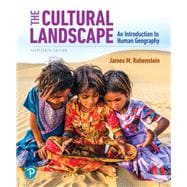About This Book
The Cultural Landscape: An Introduction to Human Geography, 13th Edition
ISBN: 9780135116159
The Cultural Landscape: An Introduction to Human Geography, 13th Edition, is a comprehensive textbook designed for introductory human geography courses. It's a go-to resource for students and educators alike, offering a detailed exploration of human geography principles and meeting scope and sequence requirements for typical introductory human geography courses.
Who Uses It?
Primarily, this book is used by students and instructors in introductory human geography courses at the college and university levels. It's also a valuable resource for anyone interested in understanding the basics of human geography, including professionals looking to refresh their knowledge or expand their understanding of geographical principles.
History and Editions
The 13th edition of The Cultural Landscape has been updated to address user feedback, incorporating the latest research and discussions on global issues and local impacts. This edition includes detailed updates on geographical concepts, ensuring that it remains current and relevant. It also includes a structured approach, making it easy to adapt to different course structures.
Author and Other Works
James Rubenstein is the author of The Cultural Landscape: An Introduction to Human Geography. James Rubenstein is known for his engaging and clear writing style, which makes complex geographical concepts accessible to students. He has written several editions of this book, each updated to reflect the latest developments in human geography.
Key Features
- Comprehensive Coverage: The book covers core concepts in human geography, including detailed explanations and examples.
- Global Issues and Local Impacts: The text reflects the interconnectedness of global issues and their local impacts, providing a holistic understanding of human geography.
- Updated Research: The 13th edition includes detailed updates on geographical concepts, ensuring that it remains current and relevant.
- Structured Approach: The book is designed with a structured approach, making it easy to adapt to different course structures.
Detailed Information
ISBNs and Formats
- Hardcover: ISBN-13: 9780135116159
- Pearson eText: Available with Mastering Geography (ISBN: 9780135729656 or 9780135729625)
- Loose-leaf: Available through Pearson (June 28, 2019)
- Rental Options: Various rental durations available from different retailers
Publication Details
- Publisher: Pearson
- Publication Date: February 18, 2019
- Number of Pages: 576
- Language: English
Other Editions and Formats
- Pearson eText with Mastering Geography: ISBN-13: 9780135729656 or 9780135729625
- Mastering Geography with Pearson eText: ISBN-13: 9780135188439
- The Cultural Landscape: An Introduction to Human Geography Plus Mastering Geography with Pearson eText: ISBN-13: 9780135188675
Related ISBNs:
- 0135729653 / 9780135729656 (Pearson eText)
- 0135729629 / 9780135729625 (Pearson eText)
- 0135188679 / 9780135188675 (The Cultural Landscape: An Introduction to Human Geography Plus Mastering Geography with Pearson eText)
- 0135188431 / 9780135188439 (Mastering Geography with Pearson eText)
This detailed information section provides a quick reference for all the available formats and sources for The Cultural Landscape: An Introduction to Human Geography, 13th Edition, making it easier to find and access the book in the preferred format.









